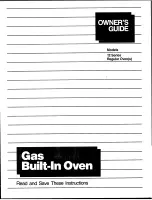
15
MICROWAVE COOKING TIPS
Shielding
Strips of aluminium foil (which block microwaves)
can be placed over the corners or edges of square
and rectangular foods to prevent those portions from
overcooking. Never use too much foil and make sure
the foil is secured to the dish or it may cause arcing in
the oven especially if the foil passes too closely to the
walls of the oven during rotation.
Elevating
Thick or dense foods can be elevated so that
microwaves can be absorbed by the underside and
center of the foods.
Piercing
Foods enclosed in a shell, skin or membrane are
likely to burst in the oven unless they are pierced
prior to cooking. Such foods include yolks and whites
of eggs, clams, oysters, potatoes, and other whole
vegetables and fruits.
Testing if Cooked
Microwaves cook food quickly, so test food for
doneness frequently. Some foods are left in the
microwave until completely cooked, but most foods,
including meats and poultry, should be removed from
the oven while still slightly undercooked and allowed
to finish cooking during standing time. The internal
temperature of foods will rise between 5 °F (3 °C) and
15 °F (8 °C) during standing time.
Standing Time
Foods are often allowed to stand for 3 to 10 minutes
after being removed from the oven. Usually the foods
are covered during standing time to retain heat unless
they are supposed to be dry in texture. Standing
allows foods to finish cooking and also helps flavors
blend and develop.
Precautions
•
Place the front surface of the door three inches or
more from the countertop edge to avoid accidental
tipping of the microwave oven during normal use.
•
To program the oven, make sure you touch the
center of each pad firmly since the areas between
the pads will not activate the oven. A tone will
sound each time a pad is touched correctly. Don’t
touch several pads at once.
•
Do not strike the control panel with silverware,
utensils, etc. Breakage may occur.
•
Always use caution when taking cookware out
of the oven. Some dishes absorb heat from the
cooked food and may be hot. See Cookware Guide
earlier in this section for more information.
•
Do not rinse containers by placing them in water
immediately after cooking. This may cause
breakage. Also, always allow the turntable to cool
before removing it from the oven.
•
Never operate the oven when it is empty. Food
or water should always be in the oven during
operation to absorb the microwave energy.
•
Do not use the oven to dry newspapers or clothes.
They may catch fire.
•
Use thermometers that have been approved for
microwave oven cooking.
•
The turntable must always be in place when you
operate the oven.
•
Do not use your microwave oven to cook eggs in
the shell. Pressure can build up inside the shell,
causing it to burst.
•
There are several precautions to follow when
microwaving popcorn:
−
Do not pop popcorn, except in a microwave-safe
container or commercial packages designed for
microwave ovens.
−
Never try to pop popcorn in a paper bag that is
not microwave-approved.
−
Overcooking may result in smoke and fire.
−
Do not repop unpopped kernels.
−
Do not reuse popcorn bags.
−
Listen while corn pops. Stop oven when popping
slows to 2-3 seconds between pops.
−
Do not leave microwave unattended while
popping corn.
−
Follow directions on bag.
ENGLISH
Summary of Contents for LMC0975 SERIES
Page 30: ...30 MEMO MEMO ...
















































